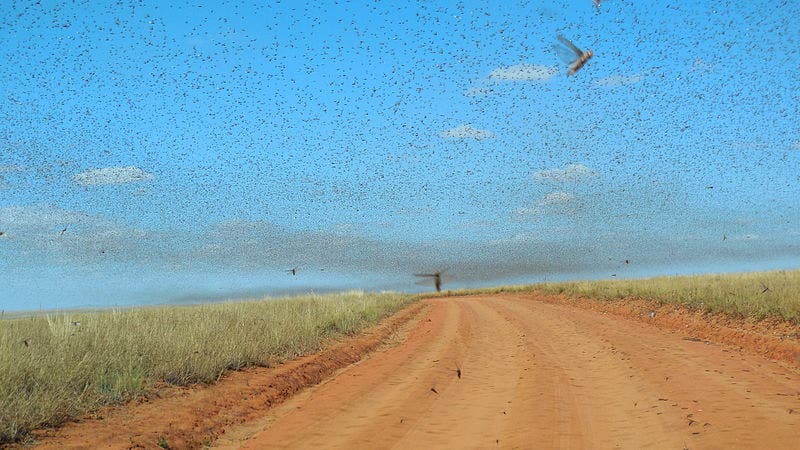
The world is almost exclusively preoccupied with the COVID-19 pandemic right now. But that doesn’t mean other plagues are sitting idle. Africa and the Middle East are experiencing an intensification in locust swarms driven by climate change. Billions of such insects travel in unison, stripping hundreds of square kilometers of vegetation at a time, threatening the livelihoods of local farmers and undermining food security.
Right now, the most effective way to fight locust outbreaks is by mass aerial sprays of pesticides. However, many countries lack the financial resources and infrastructure required to mount a long-range pest management strategy. This is why governments plagued by locusts are left scrambling for solutions — but the findings of a new study might be just what they were waiting for.
Writing in the journal Nature, researchers led by Le Kang of the Chinese Academy of Sciences in Beijing, have identified the pheromones that migratory locusts release and detect in order to swell their numbers.
The organic compound called 4-vinylanisole (4VA) is released by the migratory locust (Locustia migratoria), the most widely distributed and one of the most dangerous species of locust.
When four or more locusts congregate, they begin to release these pheromones, attracting others to the field. According to Kang and colleagues, the chemicals are detected by sensory receptors found in the locusts’ antennae.
When this olfactory receptor, known as OR35, was lacking in genetically enginered locusts, the insects were far less attracted to the pheromones.
Immediately, the researchers came up with two strategies for dismantling locust swarms. Spraying 4VA chemicals over certain areas might attract swarms in a pesticide trap. Alternatively, chemicals that disrupt the activity of the pheromones could prevent the locusts from aggregating or migrating to certain areas close to food crops.
These strategies would have to be verified by further research. One thing’s for certain, millions of people desperately depend on a solution.
Locusts have caused famines and widespread destruction since the time of Egyptian pharaohs. However, in recent times, the pests have become more and more aggressive. According to the U.N. Food and Agriculture Organization, desert locust swarms could threaten the livelihoods of 10% of the world’s population if current trends continue unabated.
The most vulnerable areas to locust invasions are East African countries, as well as those in Southwest Asia and the Middle East, including Yemen, Saudi Arabia, and Iran.
India and Pakistan are currently facing their worst locust outbreaks in the last 25 years. Ten of billions of the flying critters congregate and devour vegetation over hundreds of square miles in less than 24 hours. In Kenya, such swarms were reported to be 25 miles long by 37 miles wide.
The upsurge in locusts has been linked to extreme weather events fueled by climate change. Particularly, these last couple of years have caused wet conditions to persist, creating the ideal breeding conditions for the pests. Once they congregate, locusts can expand their swarms 20-fold every three months.
In other words, the insect swarms grow exponentially in numbers, which is why disrupting their chemical signaling before they have the chance to swell out of control may be the secret weapon against locusts we’ve been all waiting for.









